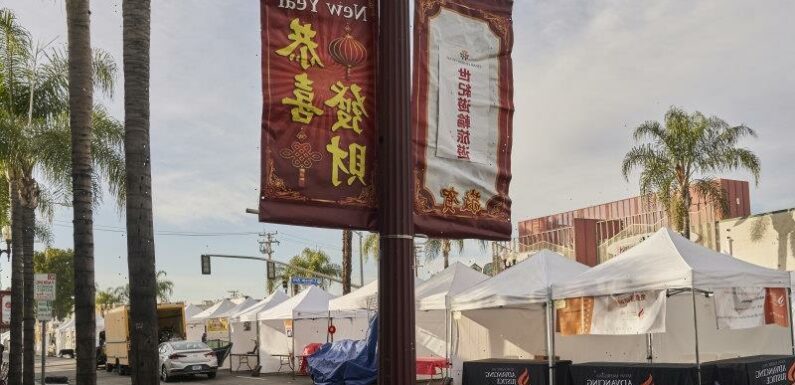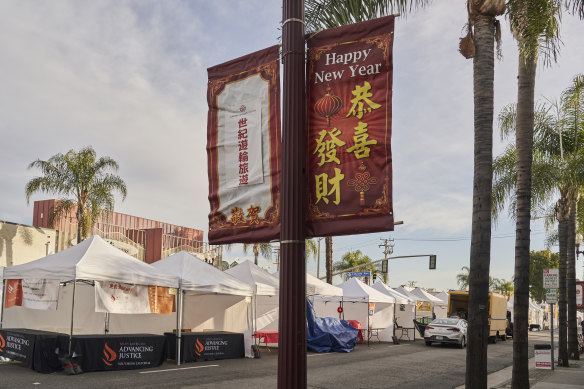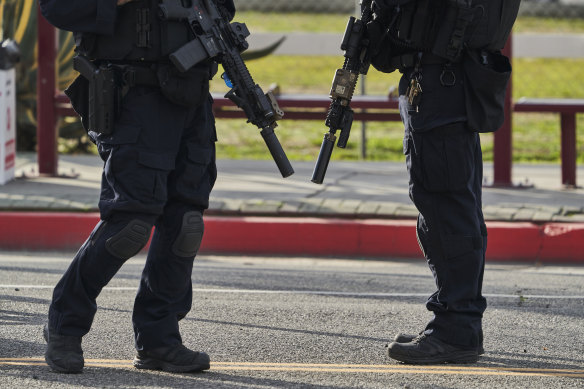
Los Angeles: It was meant to be a day that marked a new and prosperous beginning. But instead of celebrating Lunar New Year, Americans were confronted by yet another mass shooting: the 33rd to take place since the start of January.
“Who walks into a dance hall and guns down 20 people?” Los Angeles County Sheriff Robert Luna asked in disbelief on Sunday (Monday AEDT), the morning after 10 people were killed and 10 others were injured in the predominantly Asian city of Monterey Park.
endor tents for the Lunar New Year festival near where a gunman killed 10 people and injured another 10 in Monterey Park, California.Credit:The Washington Post by Philip Cheun
Hours later, after an extensive manhunt, the answer was somewhat clearer.
The man who carried out this latest mass shooting was identified as 72-year-old Huu Can Tran, who shot himself in a white van as authorities closed in.
The identities of his victims – all of whom are believed to be over 50 – have not been released, and neither has the potential motive.
But while there are still so many questions that remain unanswered, there is little doubt that this latest massacre has reignited the fear and grief felt by so many Asian Americans ever since attacks against them began to soar during the pandemic.
Police officers stand near the Star Dance Studio where a gunman killed 10 people and injured another 10 in Monterey ParkCredit:The Washington Post by Philip Cheung
The trend was brought into the national spotlight in March 2021 when a 21-year-old gunman named Robert Aaron Long went on a murderous rampage in the Atlanta suburbs, killing eight people at multiple massage parlours and spas, of whom six were Asian women.
Since then, there have been many other highly publicised violent crimes against Asians in the US and a movement in response to “Stop Asian Hate”.
“Even though [this latest incident] may not be hate-motivated, what we saw is our community members were targeted,” said Manjusha Kulkarni, co-founder of the Stop AAPI Hate advocacy group said on Sunday.
“They are very worried about going out to these celebrations and instead of it being a day of joy and celebration and renewal, it’s instead fear, anxiety and tremendous trauma.”
Situated about 11 kilometres east of downtown LA, Monterey Park is a city of 60,000 people of which 65 per cent are Asian American, 27 per cent Latino and 6 per cent white, according to census data.
That this tragedy took place just a block from the city’s famous Lunar New Year celebration, where thousands of people were meant to gather on Sunday to experience the first festival since the pandemic merely added to the community’s despair.
The rampage began around 10.20 pm on Saturday at the Star Ballroom Dance Studio, a popular place that sits among the grocery stores and Chinese restaurants of a main thoroughfare called West Garvey Avenue.
After opening fire at the venue – killing five men and five women – the gunman attempted to launch another attack at the Lai Lai ballroom in the neighbouring city of Alhambra about 20 minutes later, but was disarmed by patrons before fleeing the scene.
An extensive search to find him finally ended on Sunday afternoon when tactical teams surrounded a vehicle in Torrence that matched the description of the white cargo van Tran was believed to have fled in.
There, they discovered him slumped over in his vehicle, dead from a self-inflicted gunshot wound.
The Monterey Park tragedy is emblematic of a unique America problem. It is the 33rd mass shooting this year, according to the Gun Violence Archive, and the deadliest in the US since the Uvalde tragedy of last year, which killed 19 children and two teachers.
But there have been many other mass shootings before and since – from the racially fuelled massacre in a black neighbourhood in Buffalo, New York, to the gay club shooting in Colorado Springs last November.
Whatever the motivation, the aftermath is the same: lives are lost, communities are shattered and a deeply divided nation once again asks: why?
And it’s a frightening indictment that California is meant to have some of the strictest gun laws in the country. Indeed, California is one of eight states that bans military-style assault weapons. It also has background checks and mandatory waiting periods for gun purchases, and was one of the first places to pass “red flag” laws, which allow authorities to remove firearms from people deemed to be a risk to themselves or others.
Authorities say the gun Tran used is likely to be illegal in California, opening up the possibility that it could have come from another state with different gun control measures.
And therein lies the very problem: the status quo – where some states have strict laws, but others don’t – simply isn’t working. Until Congress acts to reinstate nationally consistent reforms, such as universal background checks and a federal ban on assault weapons, there is every indication that this week’s massacre will be the latest of many.
Crisis support is available from Lifeline on 13 11 14 and Beyond Blue on 1300 22 4636.
Get a note directly from our foreign correspondents on what’s making headlines around the world. Sign up for the weekly What in the World newsletter here.
Most Viewed in World
From our partners
Source: Read Full Article

